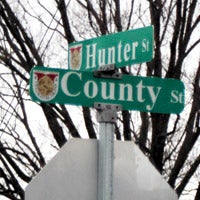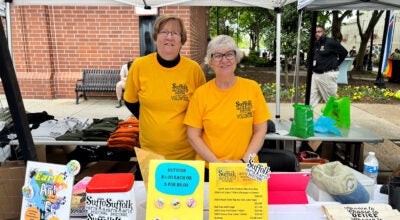A 14-year-old’s legacy
Published 8:06 pm Saturday, January 19, 2013
Gang-related death led to intense focus on Suffolk gangs
The 300 block of Hunter Street, a short stretch of small neglected abodes amid Suffolk’s peanut processing plants and truck yards, has a railroad crossing at one end and a playground on the other.
It’s where Diane Holland was shot.

The 300 block of Hunter Street, where Suffolk schoolgirl Diane Holland was shot and killed during an episode of gang violence in 2005.
Diane was a 14-year-old who, according to court records, was allegedly mixed up with the South Suffolk Gangstas. She died in Sentara Obici Hospital after receiving two gunshot wounds shortly after midnight on July 2, 2005. Authorities believed she was not the intended target of the gunshots.
The place on Hunter Street where Diane, a rising Lakeland High School freshman, fell bleeding to the ground, outside a house party near the corner with Dill Street, is closer to the playground than the railroad. A tiny cinderblock chapel sits a short distance away.
The shocking crime precipitated a zero-tolerance approach to gangs that has resulted in almost as many gang-related charges filed in Suffolk as in the rest of Hampton Roads and Richmond combined, local law enforcement authorities say.
According to Fifth District Court Service Unit figures provided by one of Suffolk’s five gang-prosecuting specialists, Nicole Belote, the jurisdiction in 2011 filed 84 gang-related charges, only three fewer than the total of those in Hampton Roads and Richmond.
Furthermore, the unit reports that intake complaints in the district under state gang laws have risen from six in 2006 to 44 in 2012.
Though the statistics could be taken as evidence of a gang crime-wave in Suffolk, that’s not the case, Commonwealth’s Attorney Phil Ferguson says.
In fact, Ferguson describes the aggressive approach, coupled with vigorous education and outreach initiatives, as having kept the city out of the clutches of violent gangs that could otherwise have taken it over.
“We have been very, very aggressive in the cases, and our goal is to completely dismantle the gangs and send the leaders to prison,” he said. “We want them out of here, off the streets.”
On Oct. 20, 2005 — 110 days after Diane Holland’s drive-by murder, a crime that Ferguson said “broke the camel’s back” after a series of shootings and slayings — the Commonwealth’s Attorneys Office convened the first meeting of a taskforce to address the city’s worsening gang violence.
More than seven years later, the taskforce, now chaired by Deputy Commonwealth’s Attorney Jim Wiser, continues to meet every other month with representatives from, among others, the police department, the school district, Western Tidewater Regional Jail, the Juvenile and Adult Probation and Parole departments, Virginia State Police and the Bureau of Alcohol, Tobacco, Firearms and Explosives.
In the wake of that initial 2005 meeting, a 14-page report on gang activity in Suffolk, which Ferguson forwarded to then-City Manager Steve Herbert on Feb. 6, 2006, detailed a nascent gang epidemic in Suffolk, proposing a law enforcement shake-up in response.
The report named some of at least 18 gangs stated to have been active in the city, including B-Squad, A-Block, the All Time Murderers and Holiday Death Crew.
“These gangs are spread throughout the city … with at least 15 gang members in each of the middle and high schools,” it stated.
With the gangs yet to reach “a great deal of territorial organization” but “continuing to evolve and adapt,” two specialized police units were proposed, one targeting downtown and the other North Suffolk. The units would have five officers apiece, and a specialized team of gang prosecutors would be attached to the cases.
The report also called for increasing the police presence on neighborhood streets and at civic league meetings.
The first Neighborhood Enforcement Team was launched in early 2007 and the second, with a North Suffolk focus, at the start of 2010. Wiser and Belote are today members of the gang prosecution team with George Bruch, Bob Sandwich and Susan Walton. They file charges under Virginia’s gang laws alongside underlying offenses whenever the opportunity arises, Ferguson said.
“We use those gang statutes probably much more than any other jurisdiction,” Ferguson explained. “It doesn’t mean we have a gang problem. What it does mean … we use all the tools available to us.”
On the education front, prosecutors and NET team officers visit each of Suffolk’s middle and high schools once a year, making a strong impression on students with videos featuring sometimes gruesome footage of gang violence and gritty testimony from former gang members, including from Suffolk.
In 2012, Ferguson said, a youth-centered outreach program distributed more than 25,000 brochures and more than 6,000 other “crime prevention items.”
Suffolk’s head-on approach, he said, was bolstered in June 2009, when Police Chief Thomas Bennett moved here from Newport News. Soon after, the second NET unit was launched.
Bennett had been deputy chief in a city whose Gang Enforcement Unit, its spokesman Harold Eley said, presently grapples with 52 active gangs.
“We sat down and talked about this issue,” Ferguson said of Bennett, whose arrival he described as “probably the greatest thing that has happened to Suffolk” in terms of gang suppression.
“Newport News has a big gang problem. … We were both dead-on in sync with what we were trying to accomplish.”
Bennett said that after evaluating Suffolk’s police department and surveying its gang milieu, “I was concerned with the beginning of gang activity in the north, generally the area of College Drive,” and he asked City Council to support the second NET unit.
The city has not tracked the cost of the gang units, but with a combined authorized strength of 10 full-time officers, it is likely to be at the higher end of the scale among local police jurisdictions in Hampton Roads.
According to city public information officers, Chesapeake’s Gang Investigation Unit, formed in March 2011, has two detectives, and Hampton’s Gang Unit, operating since 2005, has six officers. Eley declined to state the size of the Newport News unit, which has existed since mid-2009 and involves undercover operatives.
“You can address it on the front-end or you address it on the back end when you are having shootings and robberies all over the place — and murder,” Bennett said.
He argues that to decide they are under control and divert resources elsewhere would allow gangs to get a foothold in the community again.
Every community tackles gangs differently, according to Bennett. Newport News, for instance, commonly targets gang felons under federal law.
Violent crime has continued to recede in Suffolk with the targeting of gangs. According to Virginia State Police, the city had 303 such crimes per 100,000 residents in 2011, Hampton Roads’ third-lowest rate behind Hampton and Virginia Beach.
Diane Holland, the girl whose violent death was seminal in bringing about the policing strategy that is now making the streets safer, was affiliated with the South Suffolk Gangstas, a boy with her the night she was killed told a police interviewer, according to court records. The records also tie another gang to the crime: B Squad.
Gangs operating in Suffolk, like SSG, are often named after the neighborhoods they originate in, and they are either homegrown or offshoots of the “big three” transnational gangs: the Bloods, the Crips and MS-13, said police officer Ryan Linville of the downtown NET unit.
Some of the last gang charges Linville helped file, at the end of December, were against three alleged members of the Lake Kennedy Posse. Other gangs currently or recently active in Suffolk are the Hot Boys in North Suffolk, 9 Tek, the Cypress Manor Posse, the Lloyd Street Gang and 5 Money Mafia, Linville said.
Lower-rung members commit robberies, break into homes and sell drugs for money, seeing little personal benefit but rather passing the money up the chain to senior members, the officer said.
Following a robbery arrest, Linville said, the suspect told police, “I robbed them, and I gave the money back to the other people in the neighborhood gang.”
“When we talk to them one-on-one, I don’t believe any of them were born bad seeds,” Linville said. “I believe many of them made bad decisions because of drugs and alcohol or influence from others. They are smart, intelligent kids who made horrible decisions and got themselves into life-changing trouble.”
Joan Turner, now with the Commonwealth’s Attorney’s Office in a community outreach role, was supervising Suffolk Police Department’s forensics unit when Diane Holland was gunned down.
Community outrage then, Turner said, was similar to four years later when newspaper carrier John Price Jr. was shot and killed on Brewer Avenue, a crime that Ferguson says also contributed to the get-tough approach to gangs.
“Those bullets (on Brewer Avenue) went in many directions,” Turner said. “We walked many miles to try to find the casings … trying to connect the gun.”
The Brewer Avenue case was closed in February when 21-year-old Christopher Jonta Artis agreed to a plea deal, getting 10 years in prison and 30 years supervised probation.
Closing Diane Holland’s story, Danielle Monique Davis pleaded guilty to second-degree murder and malicious wounding in December 2009.
Davis, 29, received 25 years, 17 of those suspended, meaning she will likely serve eight years for the schoolgirl’s death, according to court records.
Incident reports indicate that Suffolk police continue to keep a close watch on Hunter Street, where Diane Holland was shot, regularly responding to calls there for vandalism, larceny, assault and drug possession.






